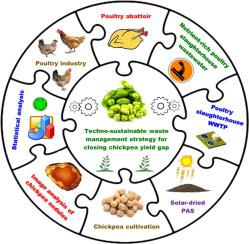Waste Management ( IF 7.1 ) Pub Date : 2020-11-10 , DOI: 10.1016/j.wasman.2020.10.030 Saim Ozdemir , Serkan Ozdemir , Hasan Ozer , Kaan Yetilmezsoy

|
Sustainable development goals imply environmentally sound management of all wastes to minimize the waste generation through prevention, reduction, recycling, and reuse. In particular, the poultry industry produces nutrient-rich waste that requires proper management. Additionally, the recycling of bio-wastes in agricultural lands is still a key technology for the sustainable use of nutrients as a renewable fertilizer. Currently, there are very few studies on the utilization of agro-industrial bio-wastes, such as poultry abattoir sludge (PAS), for crop cultivation in soils containing low organic matter and high pH. In this context, it is necessary to make a more particular assessment of poultry industry-oriented and locally available nutrient-rich organic wastes for nodulation, physiological adaptation, and crop yield. Considering the scarcity of the literature in this field, the present study aimed to fulfill the apparent gap by focusing on the applicability of recycled PAS to low fertility soil in the growth of chickpea selected as a model legume, thereby contributing to the development of an agricultural and sustainable industrial management strategy for the relevant sectors. In this study, leaf chlorophyll content and nodule color were also investigated by the image analysis methodology to describe the effects of bio-waste on closing chickpea yield gap in a marginal land with high soil pH and low organic matter. Two-year consecutive field experiments were carried out to explore the effect of the PAS with the application rates of 25 kg N ha−1 (T2), 50 kg N ha−1 (T3), and 100 kg N ha−1 (T4) along with unamended (T0) and fertilized control (T1). The results indicated that the PAS treatments significantly differed in chlorophyll content, nodulation parameters, and biomass and grain yields. The chlorophyll content was correlated (r = 0.910) with the red color value (RGB color model) of nodule image analysis in the response to bio-waste. Based on the two-year average, it was concluded that chickpea yield could be increased 45% by amending with the PAS (T3). The present study clearly demonstrated that the image analysis could be a useful digital tool for the evaluation of chlorophyll content, nitrogen fixation efficiency, and forecasting biomass and grain yields of chickpea. The results also confirmed that the PAS application to low fertility soil could prominently contribute to establish sustainable waste management and crop production alternatives for closing chickpea yield gap.
中文翻译:

技术可持续的生物废物管理策略,可缩小鹰嘴豆产量差距
可持续发展目标意味着对所有废物实行无害环境管理,以通过预防,减少,再循环和再利用来最大程度地减少废物产生。特别是,家禽业产生的营养丰富的废物需要适当的管理。此外,农业土地中生物废物的回收利用仍然是可持续利用养分作为可再生肥料的关键技术。当前,很少有关于利用农业工业生物废料,例如家禽屠宰场污泥(PAS),在低有机质和高pH值的土壤中种植作物的研究。在这种情况下,有必要对以家禽业为导向的和本地可用的营养丰富的有机废物进行更具体的评估,以结节,适应生理和提高作物产量。考虑到该领域文献的稀缺性,本研究旨在通过将再生PAS集中在被选作示范豆科植物的鹰嘴豆生长中对低肥力土壤的适用性来弥补这一明显差距,从而为农业的发展做出贡献。有关部门的可持续工业管理战略。在这项研究中,还通过图像分析方法研究了叶绿素含量和根瘤颜色,以描述生物废物对高土壤pH值和低有机质边缘地带关闭鹰嘴豆产量缺口的影响。进行了连续两年的野外试验,以探讨PAS用量为25 kg N ha时的效果 本研究旨在通过将再生的PAS集中在被选为示范豆科植物的鹰嘴豆生长中的低肥力土壤上的适用性来填补这一明显差距,从而为相关部门的农业和可持续工业管理策略的发展做出贡献。在这项研究中,还通过图像分析方法研究了叶绿素含量和根瘤颜色,以描述生物废物对高土壤pH值和低有机质边缘地带关闭鹰嘴豆产量缺口的影响。进行了连续两年的野外试验,以探讨PAS用量为25 kg N ha时的效果 本研究旨在通过将再生的PAS集中在被选为示范豆科植物的鹰嘴豆生长中的低肥力土壤上的适用性来填补这一明显差距,从而为相关部门的农业和可持续工业管理策略的发展做出贡献。在这项研究中,还通过图像分析方法研究了叶绿素含量和根瘤颜色,以描述生物废物对在土壤pH高和有机质低的边缘土地上关闭鹰嘴豆产量缺口的影响。进行了连续两年的野外试验,以探讨PAS用量为25 kg N ha时的效果 从而为相关部门的农业和可持续工业管理战略的发展做出了贡献。在这项研究中,还通过图像分析方法研究了叶绿素含量和根瘤颜色,以描述生物废物对高土壤pH值和低有机质边缘地带关闭鹰嘴豆产量缺口的影响。进行了连续两年的野外试验,以探讨PAS用量为25 kg N ha时的效果 从而为相关部门的农业和可持续工业管理战略的发展做出了贡献。在这项研究中,还通过图像分析方法研究了叶绿素含量和根瘤颜色,以描述生物废物对高土壤pH值和低有机质边缘地带关闭鹰嘴豆产量缺口的影响。进行了连续两年的野外试验,以探讨PAS在25 kg N ha施用量下的效果-1(T 2),50 kg N ha -1(T 3)和100 kg N ha -1(T 4)以及未修改的(T 0)和受精的对照(T 1)。结果表明,PAS处理在叶绿素含量,结瘤参数以及生物量和谷物产量方面存在显着差异。叶绿素含量 与结节图像分析的红色值(RGB颜色模型)相关(r = 0.910),以响应生物废物。根据两年的平均值,可以得出结论,通过使用PAS进行修订,鹰嘴豆产量可以提高45%(T 3)。本研究清楚地表明,图像分析可能是评估鹰嘴豆叶绿素含量,固氮效率和预测生物量和谷物产量的有用数字工具。结果还证实,PAS在低肥力土壤上的应用可以显着有助于建立可持续的废物管理和作物生产替代方案,以缩小鹰嘴豆的产量差距。











































 京公网安备 11010802027423号
京公网安备 11010802027423号